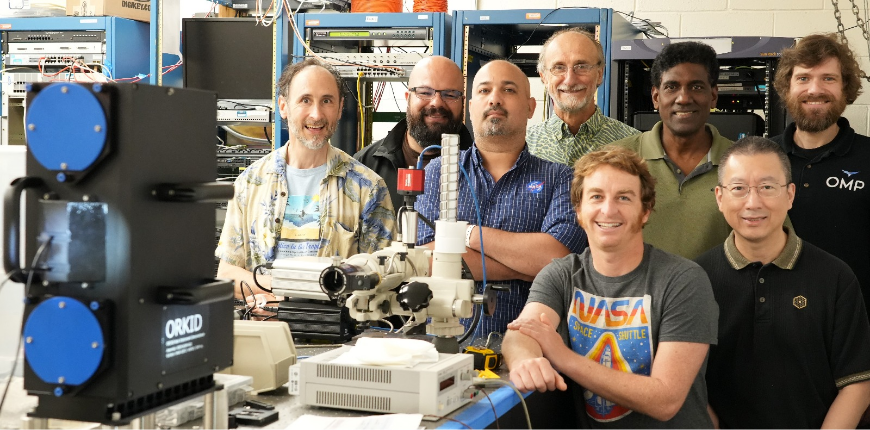A development led by an Israeli scientist has significantly improved the image quality of ground-based telescopes. “These are the sharpest images we’ll see this decade.”
A development by NASA researchers, led by Dr. Eliad Peretz, an Israeli scientist at NASA’s Goddard Space Flight Center, has yielded unprecedented-quality astronomical observations from ground-based telescopes. This breakthrough stems from a system that calibrates telescopes using a laser beam emitted from a satellite, significantly reducing atmospheric disturbances when imaging distant celestial bodies.
The experiments were conducted using NASA’s LCRD satellite, launched in 2021 to test laser communication from an orbit 36,000 kilometers above Earth. Early last year, the researchers directed the laser beam toward the Keck Telescope, a pair of 10-meter telescopes located in Hawaii. By targeting the telescope with a beam of light from space, with known wavelengths and intensity, the scientists could precisely measure how atmospheric light scattering distorts the image at a given time and location. This enables them to calibrate the telescope and its instruments accordingly and carry out observations of celestial objects with minimal atmospheric interference.
“Keck didn’t have the proper instrumentation for visible-light observations at all, so we had to develop that instrumentation ourselves,” Peretz told the Davidson Institute website.

A breakthrough that neutralizes atmospheric interference. Eliad Peretz (third from the left) with the ORKID project team | Photo courtesy of Eliad Peretz
In recent days, a scientific paper summarizing the initial observations using the system developed by Peretz and his colleagues—called ORKID—was published. The researchers demonstrated the system’s advantages by comparing it to observations from the Hubble Space Telescope, which also captures visible light images, and analyzed several celestial objects. Among other findings, they showed that the star Θ Ori C (Theta Ori C) in the Orion constellation is a binary star system. This is the sharpest image of the star to date and the first time it has been photographed at a resolution high enough to clearly reveal that there are two stars in the constellation, not just one.
In a closer observation, the researchers focused on Io, one of Jupiter’s major moons. They captured its volcanic surface in unprecedented detail and even managed to directly image the Prometheus volcano, showcasing the resolving power enabled by the new technique. “We achieved images five times sharper than Hubble’s and captured a volcano about 20 kilometers in diameter from a distance of around 100 million kilometers,” Peretz emphasized. Additional observations allowed them to identify features on the surface of the star Betelgeuse, approximately 650 light-years from Earth, whose shifting state has sparked significant scientific curiosity.
“We’re achieving image resolutions down to 15 milliarcseconds per pixel—far beyond current telescopes. That’s equivalent to a space telescope with a 9-meter mirror, which won’t be built anytime soon—if ever,” Peretz noted. For comparison, the James Webb Space Telescope has a 6.5-meter mirror. “These are the sharpest astronomical images we’re going to get in the coming decade—if not in the coming decades.”
Unprecedented resolution. Middle row: Observations of Theta Ori C using ORKID (right) compared to Hubble. Bottom row: Observations of Io's surface and the Prometheus volcano. Top right: ORKID observations of the star Betelgeuse and the asteroid Vesta | Images: NASA
Aiming High
“These observations don’t just provide impressive images—they serve as proof of concept that the technology we’ve developed has substantial scientific value,” Peretz emphasized. “This method can be used to track changes in the state of stars and galaxies, as well as to refine measurements of gravitational lensing, which scientists use to calculate the Hubble constant—the rate of the universe’s expansion.”
Peretz and his team are currently in discussions to adapt the system for additional ground-based telescopes. It’s already being tested at the Palomar Observatory in California, and integration is being considered for major telescopes like the VLT and ELT in Chile. Following the success of their initial experiment, the team is preparing a proposal to NASA for the launch of a dedicated calibration satellite. The ORCAS mission—short for Orbiting Configurable Artificial Star—will consist of two suitcase-sized satellites capable of projecting light beams in four wavelengths: two in the visible range and two in the infrared, with ground-locking capability. The satellites would orbit Earth in a highly elliptical orbit of approximately 8,000 by 178,000 kilometers.
“The proposal has been joined by two Nobel Prize laureates in physics, John Mather and Saul Perlmutter, and if approved, we could launch the satellites around 2033,” Peretz noted. “This would be a true revolution in astronomy.”
